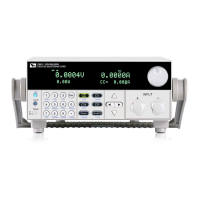Remote Control
Copyright © ITECH Electronic Co., Ltd. 10
GPIB address
The electronic load operates from a GPIB address that is set from the front
panel. To set the GPIB address, press the Shift + System on the front panel
and enter the address using the keys. The address can be set from 0 to 30. The
GPIB address is stored in non-volatile memory.
RS-232 function
The electronic load provides an RS-232 programming interface, which can be
activated and set by pressing Shift + Systemon the front panel. All SCPI
commands are available through RS-232 programming. When the RS-232
interface is selected, The EIA RS-232 Standard defines the interconnections
between Data Terminal Equipment (DTE) and Data Communications
Equipment (DCE).The electronic load is designed to be a DTE. It can be
connected to another DTE such as a PC COM port through a null modem
cable.
Note
The RS-232 settings in your program must match the settings specified in the front
panel system menu. Press Shift + System to change the settings if they don’t match.
You can break data transmissions by sending a ^C or ^X character string to the
multimeter. This clears any pending operation and discards any pending output.
RS-232 data format
The RS-232 data is a 10-bit word with one start bit and one stop bit. The
number of start and stop bits is not programmable. However, the following
parity options are selectable after pressing Shift + System:
EVEN: Seven data bits with even parity
ODD: Seven data bits with odd parity
NONE:Eight data bits without parity
Parity options are stored in non-volatile memory.
Baud rate
After pressing Shift + System,you can select one of the following baud rates:
4800/9600/19200/38400/57600/115200
The baud rate is stored in the non-volatile memory.
RS-232 flow control
The RS-232 interface supports the following flow control:
CTS/RTS: the electronic load asserts its Request to Send (RTS) line to
signal hold-off when its input buffer is almost full, and it interprets its Clear
to Send (CTS) line as a hold-off signal from the controller.
XON/XOFF: when the input queue of the electronic load becomes more
than 3/4 full, the instrument issues an X_OFF command. The control
program should respond to this and stop sending characters until The
electronic load issues the X_ON, which it will do once its input buffer drops
to below half-full. The electronic load recognizes X_ON and X_OFF sent
from the controller. An X_OFF will cause the electronic load to stop
outputting characters until it sees an X_ON.
NONE: there is no flow control.
For each case, the electronic load will send a maximum of five characters after
hold-off is asserted by the controller. The electronic load is capable of receiving
as many as fifteen additional characters after it asserts hold-off.Flow control
options are stored in the non-volatile memory.

